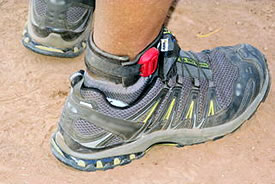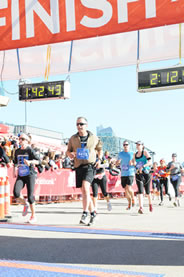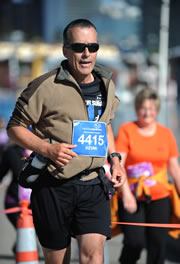Running for nature: How marathon training and conservation are very much alike

Running shoes (Photo by Jean-Yves Couput, Wikimedia Commons)
I used to smoke two packs of cigarettes a day. Then, at the age of 22, I was given an ultimatum involving kissing. At that point in my life it was the right motivation — more compelling than any arguments about heart health or cancer risk. I quit smoking, but I had already lost the chance of being athletic. Or at least so I assumed.
Two decades later I took on a stressful management job. Like a lot of people at that stage of life, I was also noticing that my waist size kept increasing so that I had to buy new pants and drill new holes in my belt. Weighing the options, I decided that a beer on the couch after work might offer short-term relief from stress, but running on a treadmill would offer a solution to both problems. Self-discipline was the issue, however: it's way easier to pop the tab on a beer than to trundle off to the gym and work up a sweat. And all the other people at the gym looked so much better than me. So I bought a treadmill. Those things aren't cheap, so I felt obliged to get my money's worth out of it. I began running most days after work.
I was pretty pleased when I reached the point where I could run 20 minutes a day. Then I read that you need 30 minutes a day to get a health benefit. So I tried harder and eventually I was doing a half hour run that my treadmill controls told me equated to more than two miles. Who would have thought I could do that?
My last job before retirement made the stress of those earlier years look like a walk on the beach. I would come home and run the angst and frustration out, the whole house shaking as I pounded that treadmill. On particularly intense days, I was running up to 45 minutes now, but the workouts took a toll on the treadmill. It died a few weeks before I retired — just as I realized my pants were all too big now.
With more time on my hands, and the imminent realities of aging on my mind, I decided it was time to do something a bit more ambitious. So I bought a book on running and signed up for the 2013 Calgary Half Marathon.

Kevin Van Tighem crossing the finish at the 2013 Calgary Half Marathon (Photo by Kevin Van Tighem)
The next months were full of increasingly challenging training runs. I learned about things like ilio-tibial bands and achilles tendonitis and so on as I worked through the process of building stronger legs and more endurance. In May 2013, at the age of 60, I ran the half marathon amidst a huge mass of humanity — not the usual environment for a loner, but surprisingly energizing — and finished the run in just over two hours.
A few weeks later, some friends and I did another informal half marathon. I have to confess: I felt pretty darned proud. I had never imagined myself as someone who could run 21 kilometres and end not only upright but grinning. The pasty-faced cigarette smoker of my university days and bulgy middle-aged guy of the 1990s were history.
This year it's the full marathon. My weekly long runs are already up to 28 kilometres. I'm feeling confident.
Marathon training involves long weeks of building cardiovascular fitness and endurance. With that foundation, the training shifts to include strength training. In the last few weeks, building on earlier work, the training plan incorporates speed work. And then it's marathon day and time to see what you can accomplish.
Conservation work is similar. The best organizations invest long years in building capacity and credibility. Then they test themselves against a few serious challenges, getting strength from success. Eventually they reach the stage where they are lean, confident and capable of not just endurance but speed.
When I think of what the staff of the Nature Conservancy of Canada, with the support of the board of directors, accomplished in the last few months in bringing the Waldron Ranch and so many other land conservation projects across the finish line in Alberta, it's hard to believe this is the same organization that once saw the Ann and Sandy Cross Conservation Area as a project that tested its abilities.
Patient, hard work over an extended period of time builds strength. It makes the once-unimaginable almost easy, and opens up possibilities of even greater future achievement. I'm using this year's Calgary Marathon as a fundraising challenge for an impressive conservation organization — the Nature of Conservancy of Canada — that has proven itself over time to be capable of more than its founders ever imagined.
Conservation is a marathon too — it's a series of marathons — and I know I'll be running with, and for, some of the best this June. I'll be raising funds for NCC through the Calgary Marathon's Charity Challenge. I'm hoping that others will join those of us who will be running not just for ourselves but for NCC. Let's choose to exceed what we once though we were capable of doing as individuals, and help NCC exceed Canada's conservation dreams too.
Running has taught me many lessons, but one of the most important is this: with dedication, discipline and patient work, we can achieve far more than we initially think possible. So let's do it!


